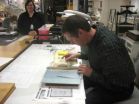(Press-News.org) Contact: Stan Samples
ssamples@kellencompany.com
404-252-3663
Calorie Control Council
Study related to diet soda and stroke risk is seriously flawed
Study is drawing a growing body of criticism and skepticism from experts in the field of nutrition and science
The Calorie Control Council stated today that research findings presented during a poster session at the International Stroke Conference claiming an association between diet soft drink consumption and increased risk of stroke and heart attack are critically flawed.
"The findings are so speculative and preliminary at this point that they should be considered with extreme caution. In fact, the study has not been peer reviewed by any independent scientists and has not been published in a scientific journal," stated Beth Hubrich, a registered dietitian with the Council.
The research, as well as the publicity regarding the study abstract, is drawing a growing body of criticism and skepticism from experts in the field of nutrition and science.
"I have to say this is one of the worst studies I've seen capturing headlines in a long time," said Dr. Richard Besser, Chief Health and Medical Editor at ABC News, commenting during a February 10 segment on Good Morning America. "It's bad because of the science, but it's also bad because of the behavior that it can induce and the fear that people have. I don't think people should change behavior based on this study."
Pointing out some of the flaws in the study, Besser added, "They didn't look at how much salt they took in, they didn't look at what other foods they ate. Those things we know are associated with stroke and heart attack. They didn't even look at obesity over time. And so to conclude from this, that it's all from the diet soda, just makes no sense whatsoever."
Dr. Walter Willett, chair of the Department of Nutrition at Harvard School of Public Health, echoed this criticism in comments presented on ABCnews.com (http://abcnews.go.com/Health/video/taking-diet-soda-study-grain-salt-12870775): "It's important to keep in mind that his was really a preliminary report. It's not even published yet, and the study was fairly small. I think we have to interpret the findings about diet soda very carefully, in almost any first report, we shouldn't really change our behavior, because it could easily have occurred by chance."
The poster presentation is also at odds with statements on the website of the American Heart Association, sponsor of the conference where this poster was presented. Regarding the low-calorie sweeteners used in diet soft drinks, AHA states: "Try non-nutritive sweeteners such as aspartame, sucralose or saccharin in moderation. Non-nutritive sweeteners may be a way to satisfy your sweet tooth without adding more calories to your diet. The FDA has determined that non-nutritive sweeteners are safe."
Among the weaknesses and criticisms of the poster:
The poster is not a published study and has not been peer-reviewed for a scientific journal. As a result, it has not been examined by experts as to design, reasonableness of conclusions, and other methodological issues. The academic standards for poster presentations are lower than for peer-reviewed scientific journals, calling the conclusions into greater question.
The soda intake data used for this presentation are of questionable reliability. They are based on self-reported consumption figures, which are grouped into general categories, such as "moderate diet only" soda consumers. This imprecision makes it very difficult to draw any meaningful conclusions from the study.
This study is observational and does not show cause and effect. As a result, the presenters' conclusion that diet soda "may be associated with a greater risk of stroke, MI or vascular death than regular soda" is not well founded. For example, the authors do not appear to have controlled for such critical factors as family history of heart disease or stroke, or for weight gain. Also, stroke is more common in men 55 years of age and older and women 65 years or older. The average age of those in the study was 69.
The sample size of those who claimed they drank diet soda daily was small – only 4.5 percent of the total study sample.
The overall study population was not representative of the U.S. population, either in age (average age was 69), or race (only 20 percent non-Hispanic white).
Cardiovascular events are very complex statistically. Many people who have had a cardiovascular event (and therefore are a much higher risk for a second, statistically) are switched to a low calorie diet which will often include diet drinks as opposed to high calorie drinks.
The authors offer no explanation or theories for why diet soft drinks might be related to an increased risk of vascular events.
Low-calorie sweeteners are some of the most thoroughly studied food ingredients in the food supply. The safety of low-calorie sweeteners has been reaffirmed time and again by leading health and regulatory groups worldwide.
###
For more information about low-calorie sweeteners, visit: www.caloriecontrol.org.
Study related to diet soda and stroke risk is seriously flawed
Study is drawing a growing body of criticism and skepticism from experts in the field of nutrition and science
2011-02-14
ELSE PRESS RELEASES FROM THIS DATE:
Sandia security experts help Kazakhstan safely transport, store Soviet-era bomb materials
2011-02-14
ALBUQUERQUE, N.M. — A Sandia National Laboratories team helped reach a major milestone in the nation's nuclear nonproliferation efforts by working with the Central Asian country of Kazakhstan to move nuclear materials — enough to build an estimated 775 nuclear weapons — to safety.
Sandia provided security and logistics expertise to complete the transfer across Kazakhstan of spent fuel containing 11 tons (10 metric tons) of highly enriched uranium and 3.3 tons (3 metric tons) of weapons-grade plutonium that had been stored in a BN-350 fast-breeder reactor in the busy Caspian ...
Wayne State study: Enhance romance by going out with other couples
2011-02-14
DETROIT— Romantic relationships often start out as enjoyable or even exciting, but sometimes may become routine and boring. A Wayne State University study reveals that dating couples that integrate other couples into their social lives are more likely to have happy and satisfying romantic relationships.
Richard B. Slatcher, Ph.D., assistant professor of psychology in WSU's College of Liberal Arts and Sciences and a resident of Birmingham, Mich., specializes in social and health psychology. His recent research suggests that spending quality time with other couples may ...
VCU Massey first to combine targeted agents to kill multiple myeloma cells
2011-02-14
Richmond, Va. (Feb. 10, 2011) – Scientists at Virginia Commonwealth University Massey Cancer Center have developed a novel treatment strategy for multiple myeloma that pairs two targeted agents to kill cancer cells. The study's findings, published in today's edition of the journal "Blood," are the first to demonstrate the synergistic, anti-myeloma effects of this combination regimen both in vitro and in vivo.
Multiple myeloma is a cancer involving antibody-producing cells in the bone marrow, and, in most cases, is incurable. Targeted therapies work by interfering with ...
University of Arizona experts determine age of book 'nobody can read'
2011-02-14
University of Arizona researchers have cracked one of the puzzles surrounding what has been called "the world's most mysterious manuscript" – the Voynich manuscript, a book filled with drawings and writings nobody has been able to make sense of to this day.
Using radiocarbon dating, a team led by Greg Hodgins in the UA's department of physics has found the manuscript's parchment pages date back to the early 15th century, making the book a century older than scholars had previously thought.
This tome makes the "DaVinci Code" look downright lackluster: Rows of text ...
Powerful new ways to electronically mine research may lead to scientific breakthroughs
2011-02-14
The Internet has become not only a tool for disseminating knowledge through scientific publications, but it also has the potential to shape scientific research through expanding the field of metaknowledge—the study of knowledge itself.
The new possibilities for metaknowledge include developing a better understanding of science's social context and the biases that can affect research findings and choices of research topics, according to an article published by University of Chicago researchers in the journal Science. Pooling research-related information online can shed ...
Roses get celery gene to help fight disease
2011-02-14
A rose by any other name would smell … like celery?
North Carolina State University research intended to extend the "vase life" of roses inserts a gene from celery inside rose plants to help fight off botrytis, or petal blight, one of the rose's major post-harvest diseases.
Some fungal pathogens, the bad guys that infect plants, produce a sugar alcohol called mannitol that interferes with the plant's ability to block disease like petal blight, which produces wilty, mushy petals – an effect similar to what happens to lettuce when it's been in the crisper too long.
In ...
JPEG for the mind: How the brain compresses visual information
2011-02-14
Most of us are familiar with the idea of image compression in computers. File extensions like ".jpg" or ".png" signify that millions of pixel values have been compressed into a more efficient format, reducing file size by a factor of 10 or more with little or no apparent change in image quality. The full set of original pixel values would occupy too much space in computer memory and take too long to transmit across networks.
The brain is faced with a similar problem. The images captured by light-sensitive cells in the retina are on the order of a megapixel. The brain ...
Study examines phenomenon of women caring for ex-husbands
2011-02-14
COLUMBIA, Mo. – The aging population, 65 years and older, includes nearly 3.8 million divorced men and women, according to the U.S. Census Bureau. Illnesses and end-of-life issues can be particularly difficult for singles without spouses or designated caregivers. A new study from the University of Missouri provides insight into the experiences of exes who care for their former spouses, offering support, assistance with daily tasks and management of health needs.
"The concept of women as caregivers for their ex-husbands is largely unexplored," said Teresa Cooney, associate ...
NASA infrared satellite data gives System 96S a fair shot at becoming a tropical cyclone
2011-02-14
A low pressure area located a couple of hundred miles northwest of Western Australia appears in a better position for development into a tropical cyclone according to infrared NASA satellite imagery. Infrared imagery from NASA's Aqua satellite shows some strong convection in the low, named System 96S.
When Aqua passed over System 96S on Feb. 9 at 17:47 UTC (12:47 p.m. EST), the Atmospheric Infrared Sounder (AIRS) instrument showed some strong convection and strong thunderstorms with very cold cloud-top temperatures around the center of circulation. Those cloud top temperatures ...
WSU researcher designs multilingual instruction materials for world's largest mall
2011-02-14
Housing 1,200 stores, an underwater zoo, a SEGA indoor theme park, an Olympic-size ice rink, a 22-screen Cineplex and the world's largest gold market, the Dubai Mall is a retail marvel that attracts tourists from around the world. Thanks to one Wayne State researcher, its multilingual, multicultural employees are using an efficient, cost-effective instructional process to learn their job duties.
Monica W. Tracey, Ph.D., associate professor of instructional technology and administrative and organizational studies in WSU's College of Education and resident of Farmington ...
LAST 30 PRESS RELEASES:
Heart-brain connection: international study reveals the role of the vagus nerve in keeping the heart young
Researchers identify Rb1 as a predictive biomarker for a new therapeutic strategy in some breast cancers
Survey reveals ethical gaps slowing AI adoption in pediatric surgery
Stimulant ADHD medications work differently than thought
AI overestimates how smart people are, according to HSE economists
HSE researchers create genome-wide map of quadruplexes
Scientists boost cell "powerhouses" to burn more calories
Automatic label checking: The missing step in making reliable medical AI
Low daily alcohol intake linked to 50% heightened mouth cancer risk in India
American Meteorological Society announces Rick Spinrad as 2026 President-Elect
Biomass-based carbon capture spotlighted in newly released global climate webinar recording
Illuminating invisible nano pollutants: advanced bioimaging tracks the full journey of emerging nanoscale contaminants in living systems
How does age affect recovery from spinal cord injury?
Novel AI tool offers prognosis for patients with head and neck cancer
Fathers’ microplastic exposure tied to their children’s metabolic problems
Research validates laboratory model for studying high-grade serous ovarian cancer
SIR 2026 delivers transformative breakthroughs in minimally invasive medicine to improve patient care
Stem Cell Reports most downloaded papers of 2025 highlight the breadth and impact of stem cell research
Oxford-led study estimates NHS spends around 3% of its primary and secondary care budget on the health impacts of heat and cold in England
A researcher’s long quest leads to a smart composite breakthrough
Urban wild bees act as “microbial sensors” of city health.
New study finds where you live affects recovery after a hip fracture
Forecasting the impact of fully automated vehicle adoption on US road traffic injuries
Alcohol-related hospitalizations from 2016 to 2022
Semaglutide and hospitalizations in patients with obesity and established cardiovascular disease
Researchers ‘listen in’ to embryo-mother interactions during implantation using a culture system replicating the womb lining
How changing your diet could help save the world
How to make AI truly scalable and reliable for real-time traffic assignment?
Beyond fragmented markets: A new framework for efficient and stable ride-pooling
Can shape priors make road perception more reliable for autonomous driving?
[Press-News.org] Study related to diet soda and stroke risk is seriously flawedStudy is drawing a growing body of criticism and skepticism from experts in the field of nutrition and science





